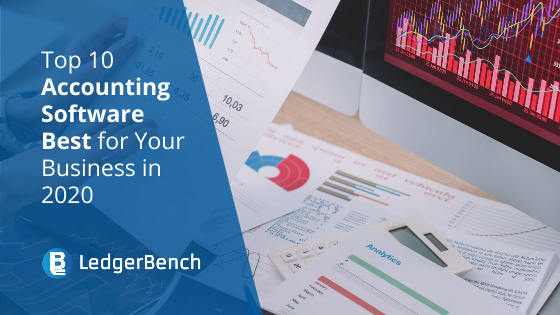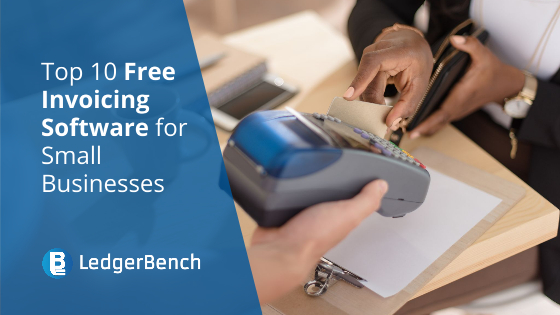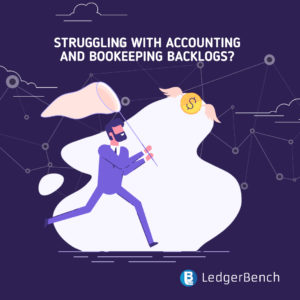
Accounting, Accounting Services, Finance, Payroll Processing
The ultimate goal of any business is to increase their financial health and profits. To ascertain this goal, it is important to keep a regular and accurate tab on the financial position of the business. As we all know, maintaining the accounting records of a business is a mammoth task and involves huge operational logistics, never-ending ledger entries, and complex transactions. Therefore, having a healthy and standardized Bookkeeping and Accounting ethic is important to run your business’ other core functions effectively.
Accounting Softwares are your answers to doing all the above-mentioned tasks with finesse, accuracy, expertise, and time effectively. In the current times of running a business, accounting software is now an integral part of your bookkeeping logistics and automates the process of maintaining accounts by eliminating the need for time-consuming manual entries.
List of top 10 Accounting Softwares:
They can escalate your business’ operations and make them smooth and stress-free.
If you are looking for an accounting tool that is seamless, fast, organized, and generates comprehensive data, all in one, then QuickBooks is your pick. This modern accounting management tool is good for users whether they are beginners or professional accountants. It is packed with powerful features like:
- Invoicing
- Banking
- Easy Dashboard
- Sales and Inventory Tracking, etc.
You can create custom professional invoices and have a completely integrated banking feature that updates your statements and transactions automatically. Get a real-time 360-degree view of your business’ operations from anywhere!
The purpose of FreshBooks is to help you carve business decisions on the basis of actual business insights and important financial data. It helps you get access to all accounting functions in cloud-based accounting software, so that you have everything you need, anytime and anywhere. Its a spectrum of usage goes from basic accounting functions to more complex operations like custom invoicing, expense management, and administering Payroll Services. FreshBooks is dynamic and scalable accounting software and it grows as your business grows.
If you are using Windows 10/8.1/8/7 and need accounting software, then Sage is the top choice on the market. No matter what your business and accounting goals are, Sage adapts itself to suit and fit your needs. You can manage your books and then extend the data on the cloud for ready availability anytime and anywhere. There are additional options of Sage Live and Sage X3 so that you can always be in tandem with the needs of the customers. The only downfall of sage is that it involves a decent learning curve and it is not something that can be readily grasped by beginners.
If you want to surpass just having an accounting software and need a complete business solution that not only streamlines your business but makes the management simpler, then Tally is the right choice for you. This accounting software is an all-rounder when it comes to a user-friendly interface, versatile businesses, key accounting features, business management capabilities, budget management abilities, and prompt banking functions. All your operational needs are taken care of by single accounting software. There is a high-grade data encryption and backup facility with a very simple installation procedure.
Wave is cloud-based free accounting software that is also one of the main choices of freelance accountants. But as it is free, its main downfall is that it has limited features, no app support and is not suitable for large businesses. However, if you are just starting up, or need to see how accounting software works, then it has key accounting features in its kitty. You can connect bank and credit cards, receipt scanning, invoicing and elementary bookkeeping and payroll functions to start your journey of using accounting software.
Zoho Books too is an all-in-one accounting solution for your business. Be it expense tracking, comprehensive and detailed reporting, banking functions, and spending management, Zoho books can do it all. Its core functions include the key accounting operations and it is ideal for small businesses. Although, we do not recommend it for large businesses as it is cloud-based and does not have effective desktop integration as well as lackluster payroll functionality.
The NetSuite ERP is a cloud-based accounting software that is designed to meet the needs of dynamic and fast-growing SMEs. It automates key accounting processes like inventory management, revenue management, order management, and key functions like accounts payable, accounts receivable, general ledger, tax management, etc.
This accounting software is trusted by millions of organizations globally to streamline their accounting requirements and also for its seamless integration with CRM, inventory, and order management tools. You get an audit trail visibility, financial planning, payroll management, and flexible invoicing amongst many excellent features of the NetSuite ERP.
SAP is an accounting software helps simplify the global accounting functions and makes it fast, accurate, and seamlessly automated so that you can continue to run your business operations without any worry. It is easily expandable and dynamic, it can synchronize with Microsoft applications like Word and Excel and is complete with basic and simple data sharing. The only cons that SAP has are that it has a complicated and time-consuming initial set up and often requires third-party support and additions to achieve its full experience.
-
Dynamics Accounting Software
Dynamics 365 is a product of Microsoft’s many competent software offerings. It automates operations wherever possible and organizes maximum accounting functions with minimum time management requirements. It is packed with quite a punch with all the basic software functions already in place like invoicing, payroll, payables, and receivables. It is built for big businesses and offers comprehensive industry-specific accounting solutions.
With over 2 million installations worldwide, Busy is the perfect accounting software for micro, small and medium-sized businesses. Its popularity is a result of the business tools and comprehensive accounting functions that it is packed with. It is based on excel functions and has a wide range of video tutorials available to be accessed from even the most remote locations.
Choose What Your Business Needs:
Every business has differing accounting needs on the basis of the industry you are in and the size and stage of your business. This blog gave you a review of the top 10 accounting software in the business and their unique strengths and functionality. On the basis of what your business needs and the scalability requirements of your organization, you can choose the accounting software that is the best fit for you. After all, the right accounting solutions will help you save time, money, and increase your accounting efficiencies so that you can run your business without any worries!

Accountants, Accounting, Small Business
Accounting in the year 2020 is more than just crunching the numbers and availing maximum tax benefits. It is about going ahead and overcoming the major challenges faced by accountants that are hindering you from achieving your goals. The failure to see these and acting on them promptly, not only affect your profits, but derail you from your path of efficiency.
This blog is a round-up of all the challenges and industry forecasts for the year 2020, and how you can act on them today, and secure your accounting practices with a clear and promising future.
Accounting Challenges Faced by Accountants Today:
-
Keeping Up With the Changes in Tax Regulations:
Tax compliance and maximising client benefits is the base task for any tax accountant. But the constant changes in taxation are making the need to keep up with the updates, more important than ever. Whether it is to do with regulations, client benefits, revenue generation, etc. or more complex changes, failing to abide by which can lead to errors and monetary fines. It is very important to be up-to-date with the current tax regulations and constantly be updated with any changes occurring during the financial year.
-
Repetitive Tasks Everyday:
As an accountant, there are chances that your daily task sheet almost always involves the same tasks in a clock-work manner. The excitement of variety or differing accounting challenges in your job is absent as an accountant. Additionally, when there is a monotony of tasks then there are chances for lack of interest and soon the creeping in of errors.
On an average an accountant works an average of 80 hours a week. And when it is the year-end, this work time almost always escalates. This leads to an exhaustive work-life balance, where you are almost always bundled under a pile of files. Not missing the need to still be innovative, vigilant and active for each of your clients. It is imperative to have a reliable back-end team as an accountant, with whom you can delegate your tasks effectively and reduce your work stress.
-
Increasing Competitiveness by the Day:
Accountancy is a swelling field with new entrants coming in each quarter. Now, with more candidates comes more competition. No matter your certifications and qualifications, each accountant is having to compete and race with an exceeding number of competitors in the field. Therefore, the need to have a typical niche and an edge that makes you more competent and different from your competitors is the need of the hour.
Also Read – Different Branches of Accounting: What Are They and How They Work
-
The Training is Never Over:
The reality of being an accountant is that you never really finish your training. There are always more certifications, qualifications and the unending need to be updated with changes in tax regulations. As an accountant, you almost always continue to train yourself in the span of your career. It is important to always be updated with refreshed knowledge and continuously evolving with new techniques and the software support in your field.
Accounting is a career that is bound by dates and timelines. Missing one by error, snowballs into multiple adverse effects, fines and troubles. Not to miss, the loss of your integrity, market value and your valuable clients. Therefore, as an accountant it is of utmost importance to understand the importance of these deadlines, abide by them and organize your work in a way that you are always ahead of your schedule. It is important to have a strong back-end team that can either ease this organization for you or come on-board and share your swelling responsibilities to ease you down.
-
Automation and AI Taking Over Traditional Accounting:
In the wake of increasing business competition, accountants are now having to compete head to head with holistic accounting softwares and AI support. It has not only brought convenience for your potential clients, but has also led to the recurrent need to understand and ace these software. The only way to get over this challenge, is to be able to understand and gain expertise on these innovations or have a team of individuals who can aid you in this field. So that you will be able to get more support and increased client satisfaction in your career.
Wrapping Up
Accounting forms the base task for effectively running any business. It is an omnipresent need of any organization, no matter how big or small it is. But behind all these truths, is the ultimate fact that accounting as a profession is not a cakewalk. There are multiple accounting challenges, problems and recurrent issues that are faced by accountants on a daily basis.
However, proper management, meticulous planning, and the right team can get you ahead of these problems and make life easier for you. Meticulous streamlining of your profession and having the right strategization can help you in taking charge of your business better. It’s time to pull up your socks and get ahead in your business with the right knowledge like never before!

Accounting, Accounting Services, Bookkeeping, Bookkeeping Services, Finance, Invoice
The base purpose of being a part of any transaction of goods and Services, or as we call it, doing ‘business’ is to be paid for it. Any transaction is considered complete and worth to be added in a business’ revenue, only when there is a final transaction of payment made. Now it is easy to go on any word processor, draft an invoicing and send it to the concerned party to wait for the payment. Or, you can always use an invoice generator and fast track the whole process.
In this blog we will tell you the best free Invoicing Software there are in the market, that you can avail and make your payment gateway easier. But before that it is important to know what are the key features that you need to look for in these software.
Some of the factors that you should keep in consideration before going ahead with a free software that aids you with invoicing are:
- You should be able to generate unlimited invoices without having to upgrade to a premium plan and pay a fee later.
- It should be simple, intuitive and fast. The learning curve needed to get a hang of the software should be minimum.
- And the most important thing in today’s day and age, is that it should be open to accepting online payments easily! Be it credit card payments, bank transfers or wire transfers.
Best Free Invoicing Software for Business in the Year 2020:
Paypal
Payment and Paypal are almost synonymous at least for millennial. This is true because it has been on and dominating the business of free invoicing software for almost 20 years now. It has a lot of recognition, credibility and the added advantage of a fully functional mobile app, that can help you with invoicing on the go! There is a dedicated tab on paypal just for invoicing where you can see the paid and the unpaid invoices easily. The customers who you send the invoices to, will also receive it on their paypal accounts, where they have the liberty to make the payments through any mode of their choice.
Shopify
This online invoice generator will make your life so much more easier. Be it from generating the bills to finally collecting the payment, Shopify makes the process increasingly easy. There is always additional credibility that it already has by being one of the greatest e-commerce platforms in the world, their custom invoice generator is of a premium standard and can do away with all your invoicing woes.
Online Invoices
Whether you are planning to create tax, simple or business invoices, online invoices has you covered. In fact, it is so organized that you do not even need to make any modifications from your end. It can support mobile devices to give you added flexibility and it also has a very convenient preview button that helps you assess the invoices before you send it to the clients.
Billdu
If you are looking for a combination of convenience and efficiency then Billdu is your go-to option. It brings in enormous ease into the process of generating invoices. There are many forms of billing included in this software. Some of them are
- Budget estimating
- Expense reporting
- Alternative forms of invoicing
There are three products that form different intensities and user bases of Billdu; these are, Billdu Online, Billdu Mobile and Billdu Page.
Zoho
Zoho is already known in the accounting business for its accounting software and wider efficiency. Because of their expertise in the business, they have now come to spread their wings wider and work in more niche fields in accounting. Their invoicing system is one such presentation. You can create invoices easily be it whatever your requirements are. From freelancers, to SMEs, Zoho’s invoicing system has something to offer to everyone.
Wave
As an accounting platform, Wave is known widely already. It is made keeping in mind small business owners and freelancers. You can track your outgoing expenses, create subsequent reports and connect your bank details as well. There are unlimited capabilities that you can get out of this software for all your invoicing needs. Be it unlimited customers, invoices, or expenses, it can handle everything.
Invoiced
If you are a freelancer and want to create invoices that are readily available then Invoiced is the right choice for you. With every invoice, you can create additional terms and conditions or notes that need to go with the bill. You can use the software to either send it via email, or download and directly send it.
Invoice Home
As a freelancer, if you need to create an invoice generator that is fast and convenient then Invoiced Home is your option. It is a beginner-friendly option where you can make invoices easily where there are templates and personalizing options. You can add logos and make it fancy. Make things uncomplicated in your billing process with invoice home.
The Invoice Machine
Again, a great deal for freelancers and businesses who want it easy. Generate invoices, manage their organization and send those invoices as well. This although is not necessarily a software as it works directly on the web browser.
Invoice Ninja
If you are looking for a premium option, then this is the way to go. Invoice Ninja has a free version as well, where there are 4 pre-assigned templates. Well, it doesn’t just end there, it also has 30+ payment gateway options and it practically accepts all of the client preferences possible under the sun. Although, if you upgrade to the premium version, you will get ten more of these templates as well as removal of the software limitations.
The Way Forward
The best way to run a business is when your logistics are not just practical, but efficient and operational. Having automated invoice processing, that is not just free, but time saving and prompt is the best way to make sure that your business transactions get the accurate and active closures it deserves. To add to that, when you have consecutive reporting, and the ability to please your customers instat\ntly by incorporating multiple payment gateways, there is nothing to stop you!
We hope that this blog helped you zero down on the best choice for your free invoicing software that can make your invoice generation stronger, accurate and faster. With seamless billing, your business can touch new heights of efficiency.

Accounting, Finance
The Revenue Recognition Principle is the concept that determines how revenue should be recognized and reflected in a business’ balance sheets and Financials Preparation statements. It differs in how one accounting principle does it than the other. The International Financial Reporting Standard (IFRS 15) was introduced by the Accounting Standards Board to provide a way to determine the revenue recognition model in its unique way. This helps improve comparisons within industries, across industries and in different parts of the capital market.
Why is the IFRS 15 Important?
The IFRS 15 is important as it helped outline the difference and therefore make a common ground between the revenue recognition of IASB and IFSB. As the guidance and principles of both differed, the IFRS 15 brought consensus to the same.
Since When is IFRS 15 in Effect?
The fresh IFRS rules have been in effect since May 2014 and the annual reporting period has begun from January 2018 and replaces all the previous revenue recognition principles.
The principle that IFRS 15 detects revenue only on the basis of whether there was an actual transfer of goods and services at the designated price. Here are the steps that need to be followed to recognize the revenue for any business:
Step 1: Identify the contract with the customers that mark their rights and obligations clearly in a transaction.
Step 2: It is then required to separate these performance obligations in the contract.
Step 3: The transaction price is then required to be determined for the exchange from thereon.
Step 4: Different transaction prices need to be allocated for distinct performance obligations.
Step 5: Recognizing revenue when the now promised goods and services are transferred under the obligations of the contract.
This five-step model is required to recognize the revenue effectively.
Also Read – A Beginners Guide To General Ledger
Let us now look into each of the steps in greater detail.
Step 1: Identify Contract with the Customer
It is imperative to first identify the contract that needs to be approved by both the parties concerned. The rights in relation to each of them needs to be specified. This is also the step where the terms for payment need to be specified. This is the step where the organization needs to make it certain that a detailed guidance for the approved contract is made to the finest details. If there is a chance of certain conditions being met, then the contract modification will be counted as a separate contract with the customer.
Step 2: Identify the Performance Obligations in the Contract
Right at the beginning, it is important and necessary to assess the goods and services that are obligated to the customer and therefore identify as a performance obligation. This could either be:
- Goods and services that are different and distinct in nature.
- Or, goods and services that are similar in nature and have the same pattern of transfer to the customer.
Step 3: Determine the Price of Transaction
The transaction price is defined as the price which is expected by the organization as an entitlement and obligation of exchange for the goods and services in trade. This assessment is done by going beyond the customary business prices.
Step 4: Allocating the Transaction Price
Although, any variable element is already considered in the agreement, but an estimation is still made available. This is done by recognizing the amount of uncertainty and variables that will be recognized. The only way that is determined is to associate it with whether its inclusion or exclusion will result in any degree of significant revenue reversal.
Step 5: Recognizing the Revenue as the Entity Completes the Performance Obligation
The control over an asset includes the ability to use and obtain benefits from an asset majorly. This includes the ability to use and obtain the actual benefits of an asset. These benefits are cash flows and they can be gotten either directly or indirectly.
To Sum Up
Revenue recognition is the base of any financial statement and the clear ability to make an analysis of what can be accounted as revenue and what not, is essential. The IFRS 15 helps entities and organizations take this call by demarcating a clear and concise process of recognizing revenue.
It’s 5 step model can help your business determine the nature of transactions, conditions of transactions, pricing and the parties of association that come together to make revenue.

Accounting, Bookkeeping, Bookkeeping Services, Finance, Small Business
In the wake of the Coronavirus Aid, Relief, and Economic Security Act (CARES Act), the United States has conferred an additional $310 billion funding to the Paycheck Protection Program (PPP) that was almost running out of funds in April. The importance of PPP is ever-important in these times of economic uncertainty as PPP is one of the few opportunities that small businesses have to obtain forgivable loans to sustain employees on the Payroll.
But, there are so many questions that are yet to be answered and cleared for entrepreneurs, especially in the light of the forgivable nature of the PPP loans.
Another burning issue here is the grey area, where many public companies confessed to having taken the PPP loan which was truly meant for small businesses with employees less than 500.
To contain such malpractices, the federal government has come out with the briefing that the authorities will audit any company that levies for loans more than $ 2 Million.
This blog will provide answers to all the commonly asked questions and queries related to the PPP loan and how it can benefit your business.
Question 1: What costs are eligible for forgiveness under the PPP?
Answer: The actual forgivable part of the PPP is dependent on certain factors. These are based on the payments made and the costs incurred during the COVID-19. These are the costs that are eligible for forgiveness in the PPP loans:
- Salary and wages or other similar payroll compensations.
- Payments that have been made in the light of sick leaves.
- Allowance for separation.
- Payments made for group health care benefits, including insurance premiums.
- Retirement benefits
- State or federal payroll taxes
- Please note that cash compensations that exceed $100,000 are exempted from this excuse. Additionally, the employer’s share of the federal payroll taxes is also exempted from being forgiven under the PPP.
Question 2: What costs are not eligible for forgiveness under the PPP?
Answer: Although the PPP loan is a breath of fresh air for businesses who are trying hard to genuinely retain their employees, there are still certain costs that are exempt from being forgiven under the PPP loan. These are:
- Payments made to independent contractors.
- Under the Family First Coronavirus Response Act, there are qualified sick leaves and parental leave wages. These, therefore, are exempt from the forgiveness under the PPP.
- If we take February 15, 2020, as the benchmark date; then any interest payments on personal property, rent payments under agreements in existence, and utility payments like electricity bills, etc. are also not permitted for forgiveness under the PPP loan.
You May Also Read – 10 Ways Your Bookkeeper Can Help You Through Covid-19
Question 3: What are the limitations of loan forgiveness?
Answer: There certainly are limits to forgiveness in the PPP loans. The first is that not more than 25% of the loan forgiveness can be linked to non-payroll costs. Additionally, proceeds directed towards advance up to $10,000 on Economic Injury Disaster Loan will also be deducted from the loan forgiveness amount.
There are two formulas to determine the forgiveness amount in the loan deduction. The FTE Method and the reduction in wages.
The loan forgiveness amount is subject to reduction by multiplying it by the following fraction. These are as follows: (This is known as the FTE method)
- The numerator of which is the average number of FTE employees per month employed by the borrower during the covered period.
- The denomination of which, as elected by the borrower is:
-
- The average number of FTE employees per month (from Feb 15, 2019, to June 30, 2019)
- The average number of FTE employees per month (Jan 1, 2020, to Feb 29, 2020)
The second is the reduction of wages method. This method is applicable as follows:
- Identify employees who did not receive the salary at an annualized rate of more than $ 100,000 for a single day in 2019.
- Compare each covered employee’s wages during the period to his/her salary during the first quarter of 2020.
- For an employee who is covered, the salary is reduced by more than 25%, then you need to apply the following formula:
-
- Multiply the first-quarter wages by .75
- Subtract the result from the covered period wages
- The aggregated dollar amount will reduce the loan forgiveness amount.
Question 4: What are the documents that you need to apply for forgiveness?
Answer: To receive the loan forgiveness, you need to comprehensively submit accurate copies of the following documents, complete and updated:
- Documentation to verify the number of FTE employees on the payroll. This also includes the payroll tax filings.
- Canceled checks, payment receipts, and transcripts of accounts verifying payments of mortgages, rent and utility payments.
- You also need to submit an authentication certificate from a representative of the business that certifies that the information and documents submitted are accurate and the amount that is requested for forgiveness, will help retain employees.
- In addition to these, the SBA can also ask you to submit additional documents to solidify and authenticate your case.
Question 5: Are large businesses with adequate sources of liquidity qualify for a PPP loan?
Answer: No, the essence of PPP loans was to help small businesses, retain employees, and sail through these financially crunching times of COVID-19 smoothly. If larger businesses, who have enough sources of liquidity take this PPP loan, then the small businesses will be crushed under undue competition. Hence, as per the federal laws, for any business that takes up a loan above $ 2 Million dollars, will have to undergo a complete audit.
What Does Your Business Need?
The essential element in COVID-19 is to sail through with as little damage as possible. With the PPP loan and the secure ability to seek forgiveness on the loan is a boon in these times. You need to seek spaces where you can seek the maximum benefits and forgiveness on the PPP loans. We hope that your essential queries were answered and cleared through this blog. For any additional query and query on the PPP loans and how it affects your business, please click here.

Accounting
With the advancement in technology and industry expertise, the way business was done and operated changed. Additionally, its internal logistics started transforming as well. Accounting was one such logistic, that has come to evolve and transform with time. This led to the inception and gradual differentiation in the different branches of accounting.
The differentiation also came to come around due to the different needs that people had with their accounting systems. This made them device branches of accounting that catered to their specific institutionalized needs.
Accounting is divided into 8 different branches. Namely,
- Financial Accounting
- Cost Accounting
- Managerial Accounting
- Auditing
- Tax Accounting
- Fund Accounting
- Accounting Information Systems
- Fiduciary Accounting
In this blog, we will not only highlight what these different branches mean but also how they uniquely operate and differ from one another.
When an organization uses structured accounting principles to record the transactions that occur in the business, then that is called financial accounting. It can be said to be the original form of accounting as a field. The purpose solved by financial accounting is that of calculating the profits and losses incurred by an organization for a particular period, and the state of their financial health and standing in a given phase.
This branch of accounting is mainly of application to creditors, banking sector, and financial institutions, etc, to assess the financial status of any organization.
When an accountant assesses the cost of a product or a service, then that process is called cost accounting. The calculation is done keeping in mind all the factors that contribute in the production of that service/product. These include production cost, manufacturing costs, administrative costs, and additional overhead charges.
The main purpose of cost accounting is to manage and efficiently work on bringing the cost of the product at a point to maximize profits, and then to also determine any potential wastage, etc.
The main purpose of this branch of accounting is to help business administrators get a more holistic understanding of the business. This helps in enhancing the decision making and additional controlling in the various activities of the business. It includes various particulars such as: budgets, expected cash flow, fund flow statements, cost-volume-profit analysis report, break even point calculation, etc.
A point to be noted here, is that management accounting and financial accounting are different from each other. Where the former aids the management of an organization in better decision making, the latter is of use to shareholders, financial institutions, etc to assess the position of the company. Also, management account information is of a confidential nature, and is thus of use and is shared only with the management of an organization.
When an external certified public accountant assesses the records and accounts of a business for its legitimacy and accuracy, then that process is called auditing. Although, there are cases of internal auditing as well, where an employee or a team of employees assess the companies accounts for accuracy and consistency from time to time on a regular basis.
Accounting, that is of special importance and use in matters related to taxation is known as tax accounting. The purpose it solves includes the preparation and filing of taxes, and dealing with their additional legal implications as well. The aim of every tax accountant is to maximize tax benefits, minimize tax payments and the preparation of financial records in order to get ready for tax filing. This also includes consultancy on different financial matters of the business, as minimizing the tax amount and maximizing savings as well as benefits is possible only when meticulous and strategic steps are taken right from the beginning.
This type of accounting is used to keep a tab of the funds that are incoming in a non-profit organization. This is done in order to make sure that the funds that thus come in are utilized in a proper way.
-
Accounting Information System
Accounting Information System (AIS) is the branch that takes care of everything that is to do with accounting systems. Ranging from: construction of accounting systems, installment, application and observation. This also includes the management of the accounting software and the further management of employees that are a part of the bookkeeping and accounting team.
When a branch of accounting is around the dealing and management of the property as a representative of an individual or a business, then it is known as fiduciary accounting. This is done with the purpose of managing and administering guardianship of property.
Wrapping Up:
There are multiple branches of accounting services and practices, but there are three main branches that form the spine of the field. These are
- Financial Accounting
- Tax Accounting, and
- Management Accounting
It is these three that are common and useful in companies that are operating in all sizes and stages of business. Add to that, there are two types of accounting methods, the first is the cash method and the second is the accrual method. Where the former is the simplest one and is used while recording when money comes in and when money goes out; the latter is used for revenue when it is ‘earned’.
Complete knowledge of the different branches of accounting can aid a business, in zeroing down what specific type of accounting expertise is required by their organization, as well as how to efficiently take care of those tasks. We hope that with the help of this blog, you will be able to make accurate distinctions between the different branches of accounting and how their variations are of integral use to your business.







